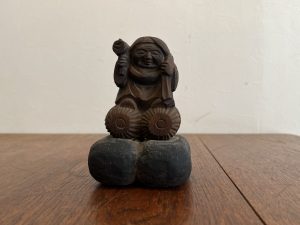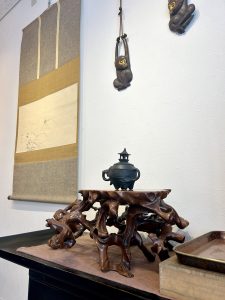みなさまこんにちは、スタッフYでございます。
本日は帝室技芸員 海野勝珉のつぶやきをしようと思っているのですが、それにしても自分にとっては「彫金」の世界がとても敷居の高い存在。まずは「彫金」とは?。深堀していきますので、少々お付き合いくださいませ。

蘭陵王置物 明治23年(1890)
彫金 28.0×32.0×33.5(宮内庁HPより)
Lan Ling King figurine, 1890
Engraving: 28.0 x 32.0 x 33.5 (from the Imperial Household Agency website)
ご存知のとおり、彫金の技術は金属工芸のなかでも長い歴史があります。
古墳時代後期(6世紀前半から半ば過ぎ頃)に渡来工人によって伝えられたとされ、冠帽(かんぼう)や指輪、簪(かんざし)などの装身具、馬具類など当時の遺物を見ると、毛彫(けぼり)や透(す)かし彫りなどの基本的技術が定着していたことがわかりますし、法隆寺や正倉院でも彫金の宝物を拝見することがありますが、当時のものと言いましてもその意匠と技術のレベルには驚きますよね。
また、平安時代(794~1185年/1192年頃)後期に武士階級が台頭するようになると、彫金は刀剣・甲冑(かっちゅう)・金具に装飾として施されることが多くなり、室町時代(1336~1573年)には後藤祐乗(ゆうじょう)を祖とする後藤家が将軍家お抱えとなり、その格式を重んじる作風が“家彫(いえぼり)”として後世に伝えられ、江戸時代(1603~1867年)になり太平の世が続くと、刀剣は実用性を重んじるものから意匠の面白さを競うものへと変化し、精密な小型の彫金の技術が完成していきます。
元禄期(1688~1704年)以降、横谷宗珉(よこやそうみん)が墨絵の筆勢そのままに鏨(たがね)で表現した片切彫(かたぎりぼり)の技法を生み出しますが、宗珉自身は武家よりも町民たちとの交わりを好み腕をふるったことから、京都風の”家彫”に対して“町彫”と呼ばれ、その自由な発想と斬新なデザインは、刀剣よりもむしろ煙管(きせる)や根付(ねつけ)などの生活用品に広がりを見せるようになり、新しい流行を生み出し、その用途は変化していきました。
今日に至るまでこうした彫金の技術は絶えることなく伝承され、主に器物、置物、装身具、神仏具などに施され、彫金は素材本来の持ち味を引き立て、格調と重みのある製品を生み出しています。そして明治期にはいりますとその意匠と技術は超絶技巧の域に入っていきます。そんな時代の過渡期に誕生したのが、海野勝珉ですが、


太平楽置物 明治期(1899年)彫金、象嵌
Taiheiraku figurine, Meiji period (1899), carving and inlaying
そんな彼の略歴を述べますと、
1844年 茨城県水戸下市肴町に伝右衛門の四男として生まれる。
1853年 叔父の初代・海野美盛や萩谷勝平に彫金を学ぶ。
1871年 江戸へ上京し、勝珉と改名。
1876年 駒込千駄木町で開業
1877年 第1回内国勧業博覧会に出品し受賞。
1881年 第2回内国勧業博覧会で褒状。
1890年 第3回内国勧業博覧会に出品した「蘭陵王」で妙技一等賞受賞。
1891年 「東京美術学校」助教授に就任
1894年 「東京美術学校」教授に就任
1896年 帝室技芸員を拝命。
1905年 勲六等瑞宝章を受章。
1915年 逝去。享年92歳

蒔絵:川之邊一朝(1831~1910)ほか
金具彫刻:海野勝珉(1844~1915)
図案:六角紫水(1867~1950)
明治36年(1903)木製漆塗・蒔絵 46.8×135.5×122.0(宮内庁HPより)
Maki-e: Kawanobe Ischo (1831-1910) and others
Hardware engraving: Katsumikazu Umino (1844-1915)
Design: Rokkaku Shisui (1867-1950)
Lacquered wood and maki-e lacquer, 1903, 46.8 x 135.5 x 122.0 (from the Imperial Household Agency website)
前述のとおり、海野勝珉が得意とする彫金の技術はもとは刀装具に施す技法だったのですが、明治政府の廃刀令により刀装具(特に刀の鍔)の制作ができなくなり、その後は金工彫刻に力を入れ制作活動を行っていきます。
多くの刀装金工達が貿易用の欧米人好みにデザインされた花瓶、煙草箱、アクセサリーなどを作って生計を立てるようになったのですが、海野勝珉はそういったものにとらわれず、新しい時代の金属工芸の姿を真剣に模索し、芸術品、美術品としての彫金作品を手掛け、数多くの展覧会に出品しその地位を築きあげます。
また、彼の作品は、鋭角な刃先を持つ小刀のような鑿で金属を彫る片切彫を得意とし、象嵌の技法を使い、様々な金属の組み合わせて作る豊かな色彩表現や、色彩感のある金銀象眼と片切り彫りを得意とし、強健な鏨の力に優美さをもつ作風であります。また、金属面に江戸の花鳥画を彷彿させる絵画世界を描くのを得意とし、写実の中に優雅な趣をみせた作風で、明治彫金界の主流を成していき、度々国内で開催される博覧会に出展した作品は高い評価を受け、明治23年(1890)46歳のときに第3回内国勧業博覧会では、雅楽の演者をモチーフにした「蘭陵王置物」を出展し妙技一等賞を受章しており、翌年には東京美術学校(現・東京芸術大学)の助教授に就任。同じ大学の教授であり当時彫金家としても活動していた加納夏雄に師事し、1894年には東京美術学校の教授に就任し学生へ技術指導をし、帝室技芸員にも任命されております。
そんな中、私が海野勝珉を知るきっかけにもなった昨年訪れた三の丸尚蔵館の収蔵品展。海野勝珉の作品「太平楽置物」を直接拝見した際には、「人間はこの域まで到達するのか…」と、その技巧に心奪われたことが記憶に残っております。どうやってこれを表現するのか技術はわかりませんが、細部までここまでに至る技術の重みと迫力は伝わりました。その迫力と重みは、時代が江戸から明治期に変わり、否応なく時代の変化に対応しなければならない苦悩と、これまでの歴史から受け継いできた技術による迫力と重みなのわかりませんが、それらがとても伝わってくる彫金でありました。
海野勝珉作品は、現在新しくなった皇居の三の丸尚蔵館にて拝見することができますので、機会がありましたら是非訪れてみてください。海野勝珉や他の帝室技芸員の作品を拝見することができます。(開催展示時期はご確認ください。)
それでは、ごきげんよう。
Hello everyone, this is Staff Y.
Today, I am going to write a tweet by Sumi Unno, an Imperial Artist, but even so, the world of “Engraving” is a very difficult one for me to understand. First of all, what is “Engraving”? Please bear with me for a moment as I delve deeper.
As you know, the art of engraving has a long history among metal crafts.
It is said that the technique was introduced by a foreign craftsman in the late Kofun period (around the first half to mid-6th century), and relics from that period, such as crowns, rings, ornaments, and harnesses, show that basic techniques such as kebori and sukashi-bori were established, and that the technique is still used at Horyuji Temple and the Shosoin Repository. The level of design and technique is astonishing, even for objects of that period.
In the late Heian period (794-1185/1192), when the warrior class came to power, engraved metal was often applied to swords, armor, and metal fittings as decoration. During the Edo period (1603-1867), as the era of peace and prosperity continued, swords shifted from being made with an emphasis on practicality to those that competed for the interest of design, and the technique of precision small-scale engraving was perfected. The technique of precision small-scale engraving was perfected.
After the Genroku period (1688-1704), Somin Yokoya developed the katagiribori technique, in which he used chisels to express the brush strokes of ink paintings. His free ideas and innovative designs spread to everyday items such as smoking pipes and netsuke rather than swords, creating new fashions and changing their uses. The use of the technique has changed over the years.
The technique of engraving has been handed down to the present day, and is mainly applied to vessels, ornaments, accessories, and sacred objects, etc. Engraving enhances the original qualities of the material and creates products with dignity and weight. In the Meiji period (1868-1912), the designs and techniques of the craftsmen entered the realm of superb craftsmanship. It was during this transitional period that Katsumikazu Umino was born,
Here is a brief biography of Katsumikazu Unno,
1844 Born as the fourth son of Den-emon in Sakanamachi, Shimoichi, Mito, Ibaraki Prefecture.
1853 Learned metal engraving from his uncle, Mimori Umino I and Shohei Hagiya.
1871 Moved to Edo (Tokyo) and changed his name to Sumikin.
1876 Opened his business in Komagome Sendagi-cho.
1877 Exhibited at the 1st National Industrial Exhibition and won an award.
1881: Awarded a prize at the 2nd National Industrial Exhibition.
1890 Awarded the first prize for his work “Lan Ling Wang” at the 3rd National Industrial Exhibition.
1891: Appointed assistant professor at the Tokyo School of Fine Arts.
1894: Appointed professor at the Tokyo Fine Arts School.
1896: Appointed as an artist to the Imperial Household.
1905: Awarded the Order of the Sacred Treasure, 6th class.
Passed away in 1915. He was 92 years old.
As mentioned above, the engraving technique in which Katsumikazu Umino excelled was originally a technique used on sword implements. However, the Meiji government’s decree banning the production of sword implements (especially sword tsubas) made it impossible for him to produce sword implements, and he subsequently focused his efforts on metalwork engraving.
Many swordsmiths began to make a living by making vases, tobacco boxes, and accessories designed to Western tastes for trade, but Katsumikazu Umino was not bound by these customs and seriously sought a new form of metalworking for a new era. His works were exhibited in numerous exhibitions, and he established himself as a leading figure in the metalworking world.
His works are characterized by his skill in katakiribori, a technique of metal engraving using a chisel like a small knife with a sharp edge. He also excels in rich colorful expressions created by combining various metals using the inlaying technique, and in colorful gold and silver inlays and katakiribori, a style that has elegance in his robust chisel power. He was also good at depicting the world of paintings reminiscent of Edo period flower-and-bird paintings on metal surfaces, and his style, which showed elegance in realism, made him a mainstream artist in the Meiji metal carving world. The following year, he was appointed assistant professor at the Tokyo Fine Arts School (now Tokyo National University of Fine Arts and Music). The following year, he became an assistant professor at the Tokyo Fine Arts School (now Tokyo National University of Fine Arts and Music). He studied under Natsuo Kano, a professor at the same university who was also active as a metal carver at the time, and in 1894 became a professor at the Tokyo Fine Arts School, where he provided technical guidance to students and was appointed a member of the Imperial Household Artists.
I visited the San-no-maru Shozo-kan collection exhibition last year, where I became acquainted with Katsumikazu Umino. When I saw his works “Lanryo-o Okimono” and “Taiheiraku Okimono” in person, I was fascinated by his technique and wondered if human beings could reach this level. I do not know how the technique was used to express this, but I could feel the weight and power of the technique that led to this level of detail. I don’t know if the power and weight of the technique comes from the struggle to cope with the change from the Edo to Meiji period and the techniques that have been engraved in the past history, but I could feel the power and weight of the engraved metal.
You can see Katsumikazu Unno’s works in the newly renovated San-no-Maru Shozo-kan of the Imperial Palace, so please visit there if you have a chance. If you have a chance, please visit there and see the works of Katsumikazu Umino and other Imperial Household Artists.
Have a good day.


























